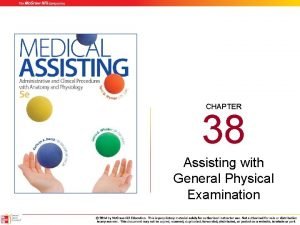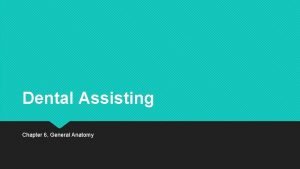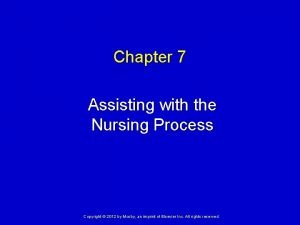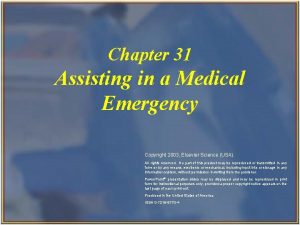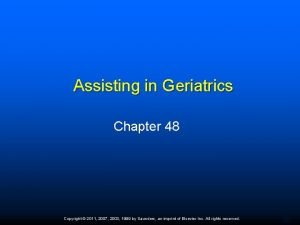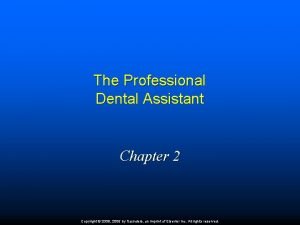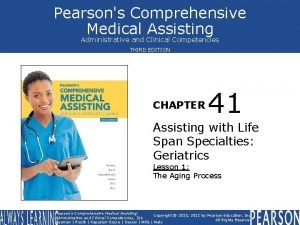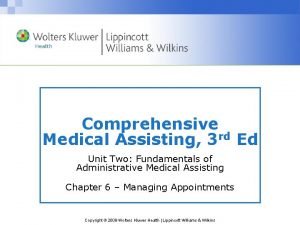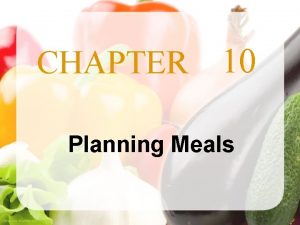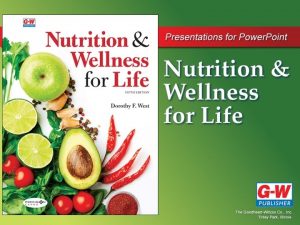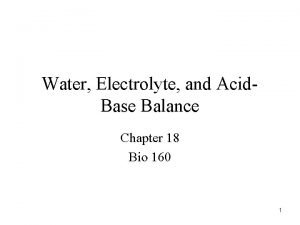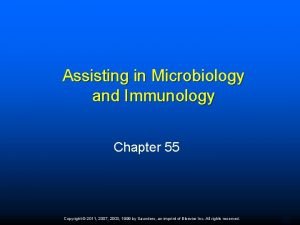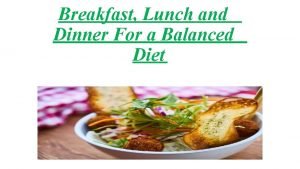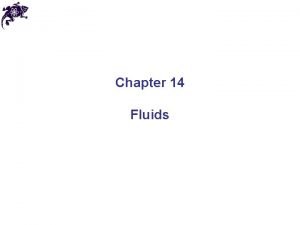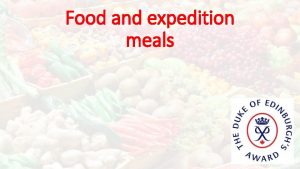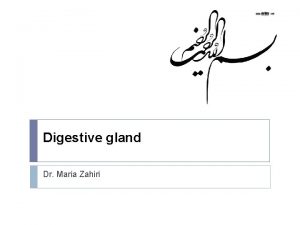ASSISTING WITH MEALS AND FLUIDS CHAPTER 14 DIGESTIVE













- Slides: 13

ASSISTING WITH MEALS AND FLUIDS CHAPTER 14

DIGESTIVE SYSTEM • https: //youtu. be/-Zyk 0 H 1 Hmj. A • https: //youtu. be/y. Io. TRGfc. Mq. M • https: //youtu. be/j. Gme 7 BRkpu. Q

NUTRITION OVERVIEW • Most necessary nutrients come from eating a variety of foods in a healthy diet. • Carbohydrates: supply body with glucose (brain, muscle, organ & cell health). Include whole grains, fruits & vegetables. • Each calorie = 4 grams. • Some carbohydrates include FIBER—which helps digestive tract function properly, lowers risk for cardiac disease & diabetes. • Less nutritious carbs include sugar, and white bread, rice & pasta. • All carbohydrates when broken down become sugar or glucose. Anything ending in “ose” is sugar. Example: fructose, lactose, maltose.

CONTINUED: • Proteins: help body build muscle & tissue, important for healing (injury or surgery). Important source of energy. Common foods include meats, poultry, fish, beans, eggs & dairy. • Protein: calorie= 4 grams. • Fats: concentrated source of energy, helps body use certain vitamins more efficiently, helps keeps us warm & protects internal organs. Healthy fats include olive oil, coconut oil, unhealthy fats include those in red meat, margarine & lard • Fats: 1 calorie=9 grams. • Only need small amount in diet which should contain protein, whole grain carbohydrates, and some fat. • Vitamins & minerals: small molecules that help regulate body functions, form cells & tissues. Minerals include: calcium, potassium, magnesium, iron, sodium, & iodine. Vitamins include: A, B, C, , D, E, & K

DIET EFFECTED BY: • • • Personal tastes Allergies & intolerances (ex. Gerd, spices, digestion, ) Culture & Religion Budget: finances, less expensive foods usually higher in carbs & sugars. People who can’t read, or English as 2 nd language may be unable to read labels. Willingness or ability to cook (elderly, dementia, disabilities, loneliness, depression) Appetite: changes with age &/or illness (chemo, meds) Anorexia: medical terminology for the loss of appetite Factors that can cause anorexia: nausea, medication side effects, depression, impaired sense of smell.

THERAPEUTIC DIETS • Soft, Mechanical, or Pureed • Soft: soft & mashed foods (potatoes, custards) • Mechanical: chopped up very small or ground up • Pureed: blended foods to smooth consistency. • Liquid Diet • Clear liquid: be able to see through (broth, jello, ginger ale • Full liquid: foods that will turn liquid at room temp, such as • ice cream, and liquids such as juices, frappes, soups. • Sodium-Restricted Diet: no salt • Many foods contain salt and therefore can not be eaten such as deli or processed meats, pickles, & cheeses. Boxed or prepared foods.

CONTINUED: • Carb-controlled: specific number of carbs per day determined by dietician. Often used for diabetic’s, or insulin resistance. Meals planned so that daily budget is spaced out to keep blood sugar level regulated. • Calorie Restricted: 1200, 1500, 1800 calorie diets usually for weight control. Additional vitamin & minerals. Used for patients with sedentary lifestyles due to injury or disability such a wheel chair bound or paralysis. • Heart Healthy Diet: Cardiac Diet • Low in unhealthy fats, decaffeinated coffee, lean meats & • low fat milk, high in vegetables, fresh fruits & omega 3 • fish, and whole grains. No fried foods, foods cooked by • steaming, poaching, grilling or baking. • High Protein Diet: To rebuild injured tissue. MD & dietician prescribes

• Meal Supplements: Ensure, Boost etc. Ordered by MD to supplement meal intake. Prepare according to patient preference (cold, over ice, frozen, room temp. etc. Contains carbs, protein & some fat. • Thickened Liquids: Thickening agent (powder or granules) added to liquids like juice or coffee and thickens it to a nectar, honey or pudding consistency without changing the taste of the food. Used for patients with swallowing difficulties (stroke, ALS). Thin liquids are easier to aspirate. • NPO status: nothing by mouth (this includes water). Pre & post procedure, and intestinal illnesses or to “rest the gut”. Very difficult for patient particularly during cooking (odors) and meal times. Also cause increased dryness to mucous membranes therefore mouth care is extremely important and must be done often!

MEAL TIMES • Highlight of the pt’s day! Involve pt. in food decisions, and support rituals & traditions related to eating (ex. Blessing) • Create pleasant, clean, relaxing environment. (in room make sure bedside table is clean, no open urinals, no unpleasant odors, mouth care prior to meals) • Encourage healthy eating (proteins before sugars) • If difficult to use utensils—encourage finger foods or ask for adaptive equipment to promote independence. • It can be tiring to eat (uses energy) especially for patients with respiratory problems. Resting in between may result in improved intake. • Amount of food can be overwhelming for some—break down 3 meals into six smaller meals over the course of the day.

ASSISTING THOSE WITH IMPAIRMENTS • Visual impairments: Identify foods • Open cartons • • Cut up meats, vegetables Describe where food & utensils are using clock face. • Difficulty swallowing: Remain with them during meal • Use thickeners if ordered • Small bites or spoonful • Don’t converse while eating—pt. can choke or • aspirate when talking • Sitting up or High Fowlers • Keep head elevate 30 min. -1 hr after meals • Eat slowly & concentrate on chewing • Assess if pt. swallowing or pocketing food in checks • or side of mouth

FLUID BALANCE AND DEHYDRATION • Importance of fluids: Ølive longer without food than fluids Ø basis for important body fluids (blood, cells, sweat, urine, mucous ØSweat—cools body temperature ØUrine—removes waste products ØBlood—circulates carrying nutrients & O 2 • Fluid Balance—intake must be consistent with output, otherwise dehydration or edema occurs • Edema—retaining excess fluid—most obvious places include feet & ankle, calves, abdomen, coccyx. Causes include heart conditions (CHF), kidney disease, liver disease, diabetes, poor circulation, immobility, high salt diets.

DEHYDRATION • Fluid loss: vomiting, sweating, excess urination, fevers, diarrhea, or severe blood loss. • Signs of dehydration: confusion, poor skin turgor dry mucous membranes (in children—lack of tears when crying) Know the symptoms on pg. 239 & handout • Dehydration can happen quickly (< 24 hr. ) and result in death! In humid weather it is most important to increase fluid intake particularly in elderly & children!

HELPING THE DISABLED TO EAT INDEPENDENTLY • https: //www. youtube. com/watch? v=A 6 w 8 b. Oifi. Vg • https: //www. youtube. com/watch? v=vy. LI 3 OA 0 -J 4 • https: //www. youtube. com/watch? v=z. Che. Acp. Fk. L 8 dehydration • https: //www. youtube. com/watch? v=IAn. L-Viyd 5 M
 Chapter 42 assisting in other medical specialties
Chapter 42 assisting in other medical specialties Assisting with a general physical examination
Assisting with a general physical examination Chapter 6 general anatomy
Chapter 6 general anatomy Chapter 5 assisting with the nursing process
Chapter 5 assisting with the nursing process Chapter 31 assisting in a medical emergency
Chapter 31 assisting in a medical emergency Chapter 41 assisting in geriatrics
Chapter 41 assisting in geriatrics The adaa was formed in 1924 by:
The adaa was formed in 1924 by: Pearson's comprehensive medical assisting
Pearson's comprehensive medical assisting Chapter 42 assisting in other medical specialties
Chapter 42 assisting in other medical specialties Chapter 10 planning meals
Chapter 10 planning meals Planning meals chapter 10 study sheet
Planning meals chapter 10 study sheet Chapter 18 fluids and electrolytes
Chapter 18 fluids and electrolytes Assisting in microbiology and immunology
Assisting in microbiology and immunology Balanced meals for breakfast lunch and dinner
Balanced meals for breakfast lunch and dinner

